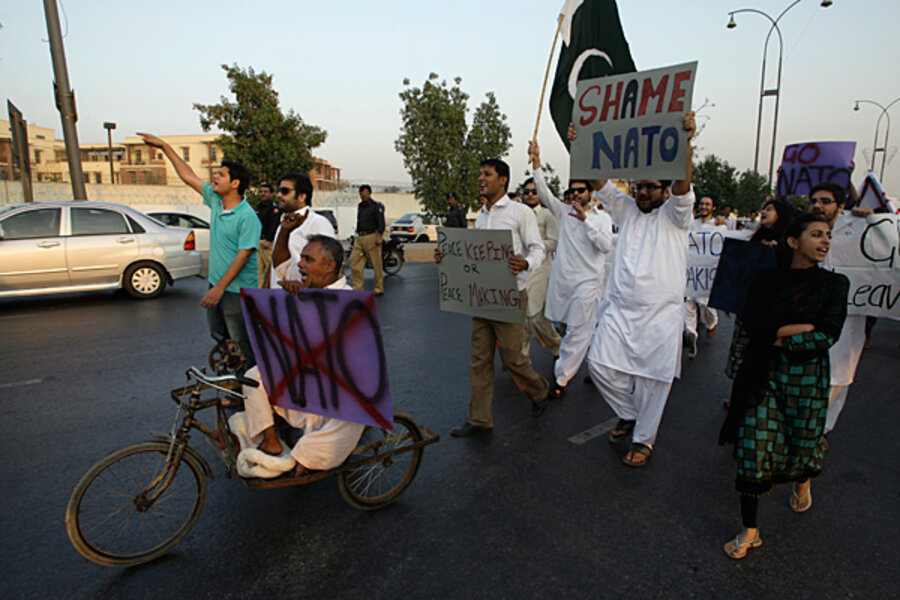Pakistan makes its case in Washington: deadly NATO attack was no mistake
Loading...
| Washington
Pakistan is offering a view of what happened in NATO’s deadly attack on a pair of Pakistani army border outposts last month that concludes that the operation could not have been a mistake – and that the shooting by helicopter gunships that left 24 Pakistani soldiers dead continued for an hour after NATO forces said it would stop.
Senior Pakistani officials made their presentation in Washington Thursday amid a downward spiral in US-Pakistan relations that began early in the year but has accelerated while the two uneasy partners trade allegations in the aftermath of the Nov. 26 attack.
On Wednesday the House of Representatives approved a freeze on $700 million in military aid to Pakistan. For its part, Pakistan has evicted the US from an airbase where drones were stationed, has closed its borders to the transfer of NATO supplies into Afghanistan – and is now proposing to charge NATO transit fees for using Pakistani supply routes if and when the borders reopen to NATO.
It was amid that heightened tension that the Pakistani Embassy in Washington summoned reporters Thursday to hear the Pakistani view of the attack on the outposts. “We want to offer our view of the incident as we see it,” said acting Ambassador Iffat Gardezi.
NATO is proceeding with its own inquiry into the incident, but Pakistan has refused to cooperate with that investigation. Ambassador Gardezi suggested that the Pakistani public would not tolerate any sign of their officials’ cooperation with NATO so soon after the deadly attack.
“This is the fourth incident [of NATO attacking Pakistani forces] in the recent past, there were joint inquiries before and nothing happened after that,” she said. “The entire population is against any cooperation at this time – they want an apology.”
President Obama has offered condolences for those killed in the attack but not an official apology.
The senior Pakistani officials who offered the presentation said the explanation of mistaken identity (NATO has said its forces thought they were firing on militants) could not be accepted for a list of reasons, ranging from the years of cooperation and the procedures put in place to prevent this kind of mistake, to the barrenness of the terrain where the simple stone outposts sat. The stark, treeless landscape meant the two outposts that were attacked stuck out and could not be mistaken for something else, the officials said.
Pakistan’s military had recently undertaken an anti-militant operation in the border area of Mohmand province where the two attacked outposts were located, but the senior officials acknowledged that parts of the Afghanistan side of the border were “infested” with what they called “terrorists.”
“We cleansed this area of all terrorist presence,” one senior official said, “As of September [there was] no terrorist presence in Mohmand which warrants such an operation” by NATO.
The officials also claimed a “coordination of measures over the last 10 years to avoid incidents of this nature,” but the details provided in the presentation served instead to illustrate the mistrust that exists between the NATO and Pakistani sides.
NATO and the Afghan and Pakistani militaries jointly man a number of Border Coordination Centers (BCCs) to enhance cooperation on border operations. Despite that, the Pakistanis say they had almost no advance warning of the Nov. 26 operation.
“No information was shared by [NATO] about an impending operation,” a Pakistani military official said. When the Pakistani officer at one BCC was provided coordinates of the attack’s location some 10 to 15 minutes before it commenced, they indicated an area six to eight miles north of where the attack actually took place.
According to the Pakistanis, strafing commenced shortly after midnight involving the first outpost, “Volcano.” Pakistani soldiers responded with 12.7 mm anti-aircraft guns. With that, the second outpost, “Boulder,” came under attack.
The Pakistanis say they received confirmation from NATO at 1:05 that the helicopters had been pulled back. But according to the Pakistanis, firing continued intermittently until sometime after 2:15, or about an hour and a quarter after NATO said its helicopters were called back.
The senior officials said the 10-15 minutes notice given the Pakistani official before firing commenced was not enough time. NATO has suggested its forces were in “hot pursuit” of militants fleeing toward the border and could not wait.
But the scenario also raises questions about the degree of trust between NATO and Pakistani officials. Some US and NATO military officials have raised concerns in the past that in some cases the Pakistani military has shared information with militants about NATO operations and positions.
The senior Pakistani officials refused to speculate about why NATO officials might have been reluctant to share information about the Nov. 26 operation. One said only that the point of years of “cooperation” was to enhance trust in order to defeat a common enemy.
“We have been working hand and glove with our partners and friends to prevent this sort of thing from happening,” he said.





